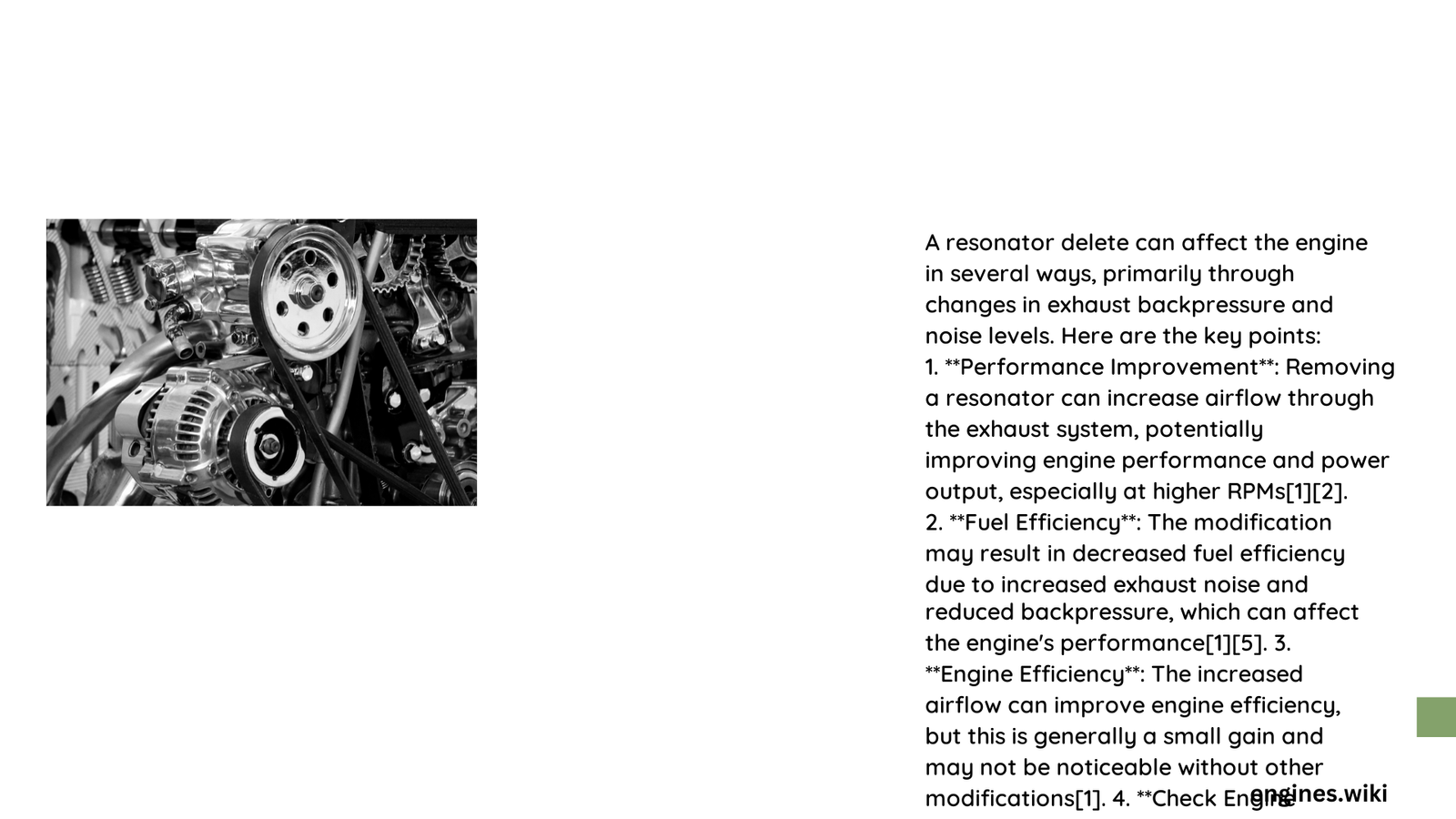A resonator delete represents a nuanced automotive modification that subtly influences vehicle performance. While many enthusiasts seek enhanced sound and potential power gains, the actual mechanical impact remains minimal. Understanding the intricate relationship between resonator removal and engine dynamics requires a comprehensive examination of exhaust system engineering, acoustic principles, and vehicle-specific characteristics.\n\n## What Happens to Engine Performance After Resonator Delete?\n\nResonator deletion introduces complex interactions within the exhaust system that marginally affect engine metrics. Vehicle owners should understand the multifaceted implications before proceeding with modifications.\n\n### How Does Resonator Delete Impact Horsepower?\n\nPerformance Metrics Breakdown:\n\n| Performance Aspect | Potential Change | Significance |\n|——————-|—————–|————-|\n| Horsepower | +2-5 HP | Minimal |\n| Torque | Negligible | Insignificant |\n| Fuel Efficiency | Potential Slight Reduction | Low Impact |\n\n#### Key Performance Observations\n\n- Minimal horsepower gains (typically 2-5 HP)\n- No substantial torque improvements\n- Potential marginal fuel efficiency reduction\n\n### What Occurs in Exhaust Flow Dynamics?\n\nResonator removal creates subtle modifications in exhaust gas movement:\n\n1. Reduced Backpressure\n – Slight decrease in exhaust system resistance\n – Minimal impact on overall engine performance\n\n2. Flow Characteristics\n – Marginally improved exhaust gas velocity\n – Limited effect on engine efficiency\n\n### How Does Sound Profile Transform?\n\nSound transformation represents the most noticeable modification:\n\n- Acoustic Changes\n – Increased exhaust volume\n – More aggressive tone\n – Potential drone at specific RPM ranges\n\n### Will Engine Management Systems Detect Modifications?\n\nModern vehicle systems possess sophisticated monitoring capabilities:\n\n- Potential check engine light activation\n- Adaptive fuel mapping adjustments\n- Minor sensor recalibration requirements\n\n### What Technical Considerations Exist?\n\nCritical Evaluation Factors:\n\n- Vehicle make and model specifics\n- Existing exhaust system configuration\n- Emission compliance regulations\n- Warranty implications\n\n## Expert Recommendations\n\nProfessional automotive technicians suggest:\n\n- Consult vehicle-specific performance data\n- Consider professional installation\n- Understand potential warranty limitations\n- Evaluate local emission regulations\n\n### Technical Precision\n\nResonator delete represents a nuanced modification with minimal mechanical impact. While enthusiasts might perceive slight performance enhancements, empirical evidence suggests predominantly aesthetic modifications.\n\n## Final Technical Assessment\n\nA resonator delete marginally affects engine performance, primarily influencing acoustic characteristics. Mechanical changes remain subtle, with negligible power or efficiency transformations.\n\n### Recommended Next Steps\n\n1. Professional consultation\n2. Comprehensive vehicle diagnostics\n3. Performance baseline measurement\n4. Careful modification evaluation\n\n## Reference:\n- SAE Technical Papers on Exhaust Modifications\n- EPA Emission Modification Guidelines\n- Automotive Engineering Performance Studies

